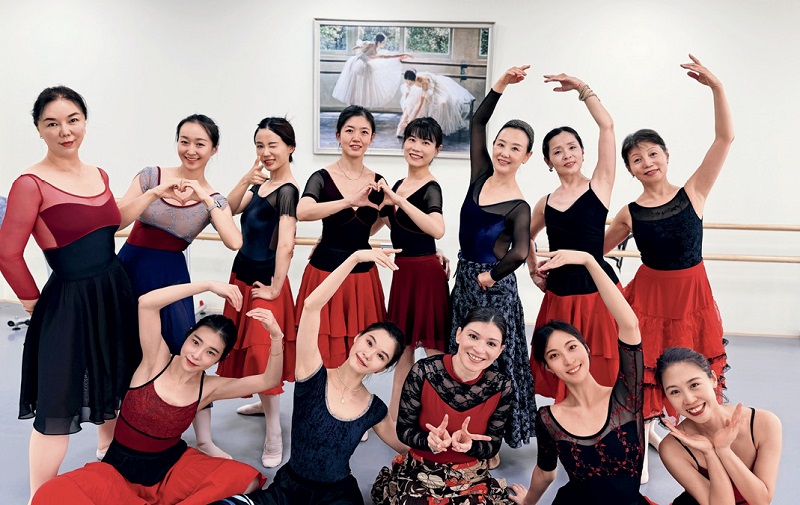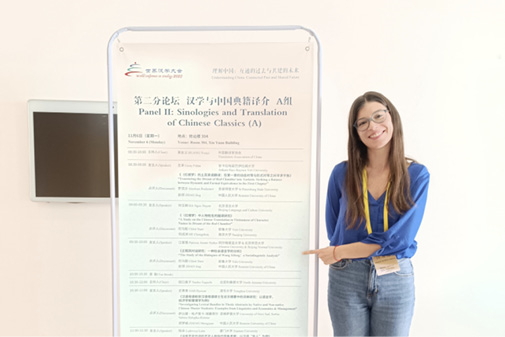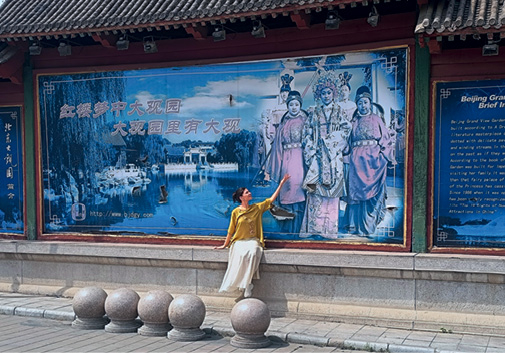From a Ph.D. student to a budding sinologist, a young Spanish woman explains her vision for more cultural exchanges between China and her country.

Patricia Amate Núñez (first row, middle) takes a group photo with her “ballet family” in China.
Dream of the Red Chamber, Cao Xueqin’s classic about the rise and decline of a family that is also a portrayal of its contemporary Qing Dynasty (1644-1911), continues to inspire and influence long after it was published in the 18th century. Patricia Amate Núñez is a current acolyte.
The Spanish student, whose interest in China began when she was a child thanks to her father’s interest in kung-fu, has recently obtained her Ph.D. degree after finishing a research project on Dream of the Red Chamber under a joint program of Beijing Normal University and University of Almeria in Spain. She moved to Beijing in November 2022 to work on her dissertation under Professor Zhao Wei of Beijing Normal University.
Her dissertation analyzes 982 dialogues by four prime women characters in the novel. They are Grandmother Jia, the stately dowager who is the grandmother of Jia Baoyu, the protagonist of the novel and heir to the fortunes of the Rongguo House; Xue Baochai, the beautiful, talented wife of Baoyu who, however, is destined to be neglected by her husband as he mourns the death of his first love; Wang Xifeng, a strong character married to Baoyu’s elder brother who turns out to be a sybaritic womanizer; and Granny Liu, a rustic distant relative whose simplicity serves as a foil for the complex and aristocratic Jia family.
Patricia analyzed the four women’s dialogues using the Dell Hymes SPEAKING model. Accoding to American sociolinguist Dell Hymes (1927-2009), to understand what someone says, it is not simply enough to consider the words. Attention should be paid to several other aspects, including situation, participants, ends, acts, key, instrumentality, norms, and genres of communication – in short, SPEAKING.

Patricia Amate Núñez participates in the seminar “Sinologies and Translation of Chinese Classics” in Beijing in 2023.
Literature Transcends Borders
What made her choose a novel that is not exactly a household name in Spain? She says her interest in Dream of the Red Chamber began at university, when a professor spoke about it in a class on classical Chinese literature. Once she started reading the book, she discovered that within its pages lay all the knowledge about China that she was looking for. She regards it as the pinnacle of China’s literary history, invaluable for research. “It is essential reading to learn about the history and customs of imperial China, and also to learn about China today. Many of the traditions the novel mentions are still alive in China,” she said.
Besides, under the initiative of renowned Spanish sinologist Pedro San Ginés, Dream of the Red Chamber was translated into Spanish by Peking University professor Zhao Zhenjiang, Spanish poet José Antonio García Sánchez, and Alicia Relinque, director of the Confucius Institute of University of Granada and translator of The Peony Pavilion.
During the two years that Patricia spent researching in China, she enjoyed seeing Dream of the Red Chamber in various art forms, including the ballet, opera, and concert. Besides being fascinated by the love triangle in the story, Patricia admired Granny Liu’s kindness and simplicity, and fell in love with the tragic Xiangling, the young maid in the novel who is kidnapped as a young girl and sold to the Jia family, alternating between being abused and periods of respite. “I found Granny Liu to be one of the best communicative characters,” she said. “She is good at seeking help, practices the traditional Confucian virtues, and also takes care of the younger generation after the fall of the Jia family.”
When she returned to Spain to defend her dissertation, she passed with flying colors. For that she is especially grateful to Professor Zhao who she said “gave me the courage to complete the voluminous research.” Also, the School of Sociology was like an “international family, where the professors, secretarial assistants, students, and staff gave me all the help I needed.”
Today, Patricia wears several hats. She is a member of an innovative teaching project at the University of Almeria, “Theatron: Dramatization as a Teaching Resource in Higher Education.” Her wish is to work in a field related to knowledge about China and its culture. For that, she says she still has a lot to read as Chinese literature is so immense. Her favorites include The Peony Pavilion, the 16th century tragicomedy by Tang Xianzu (1550-1616), who has been called China’s Shakespeare and the novel likened to Romeo and Juliet but with a happy ending. She regards the heroine Du Liniang as one of the first women characters in Chinese literature who seeks to create her own destiny in defiance of parental authority.
She also loves Shen Fu’s Six Records of a Floating Life, an autobiography set in the Qing Dynasty unfolding six parallel layers in a man’s life, loves, and career, because it delves into marital relationships in ancient China. Patricia is particularly interested in Chinese women writers and literary work that tells women’s stories such as Suicide Diary by Ding Ling, one of the most celebrated Chinese women authors of the 20th century, and San Mao’s Stories of the Sahara, an amazing real-life account of her life and adventures in the Western Sahara in the 1970s.

Patricia Amate Núñez visits the Beijing Grand View Garden in Xicheng District of Beijing, which is described as the mansion of the Jia Family in the Dream of the Red Chamber.
Embracing Other Cultures
Cultural exchanges have flourished between China and Spain, both through the efforts of individuals and the initiatives of the state. In September 2024, Spanish Prime Minister Pedro Sánchez paid a visit to China and on the occasion, an Instituto Cervantes center was opened in Shanghai, becoming Spain's second cultural center in China. Luis Garcia Montero, director of Instituto Cervantes, said the Shanghai center will take mutual understanding and cooperation to a new level.
In 2023, China and Spain celebrated the 50th anniversary of their diplomatic relations and this year marks the 20th anniversary of their comprehensive strategic partnership, leading to anticipations of a higher level of bilateral relations.
From her own experience, Patricia has seen how culture opens the door to other civilizations. For example, she loves ballet. “I studied ballet for 15 years from the age of three. It has become an essential part of me,” she said. In Beijing, she enjoyed the performance of Dream of the Red Chamber by the National Ballet of China. The graceful movements of the dancers, the harmonious music and singing and special effects unique to Chinese ballet, such as using the long sleeves of the costume to convey special effects, helped her appreciate the Chinese form of ballet.
She was also delighted to be able to continue learning ballet in Beijing and formed a little “ballet family” with her teachers and classmates. She also learned classical dancing at the Beijing Dance Academy for a semester. “I found the way of moving the hands in Chinese dances especially expressive, very beautiful and delicate. The ballet and Chinese folk dances have a lot in common, both are an art of body language,” she said. “But there is no dance academy in Spain that teaches Chinese dancing, so most Spaniards cannot appreciate the beauty of this art. As a result, few Chinese ballet troupes come to Spain.”
She said it was the same with museum exhibitions, which did not tour Spanish cities regularly. The reading clubs in Spanish universities also rarely had Chinese literature sessions. “I hope there are more and more cultural exchanges between the two countries,” she said. “For example, high schools could have courses to teach young people about Chinese culture, China’s development of science and technology, and the achievements in ecological protection.”
According to her, there should be cross-cultural activities for the elderly. Grandparents are usually retirees with a lot of time and may be curious about new things. Therefore, tai chi could be offered in the centers for senior citizens, which will not only strengthen the body, but also help people understand Chinese culture. It might also trigger their interest in traveling to China to see first-hand what they have learned.
“There are so many places worth seeing in China,” she said. In 2015, to complete her master’s thesis on an ethnic community, she lived in Kunming, southwest China’s Yunnan Province, for 18 months. “The people there are kind and lovely, the climate is pleasant, and various ethnic groups live together in harmony, making it a perfect place!”
She advocates cultural exchanges via language teaching, youth exchanges, and tourism, so that the people of the two countries have more communication and the tree of bilateral friendship remains evergreen.